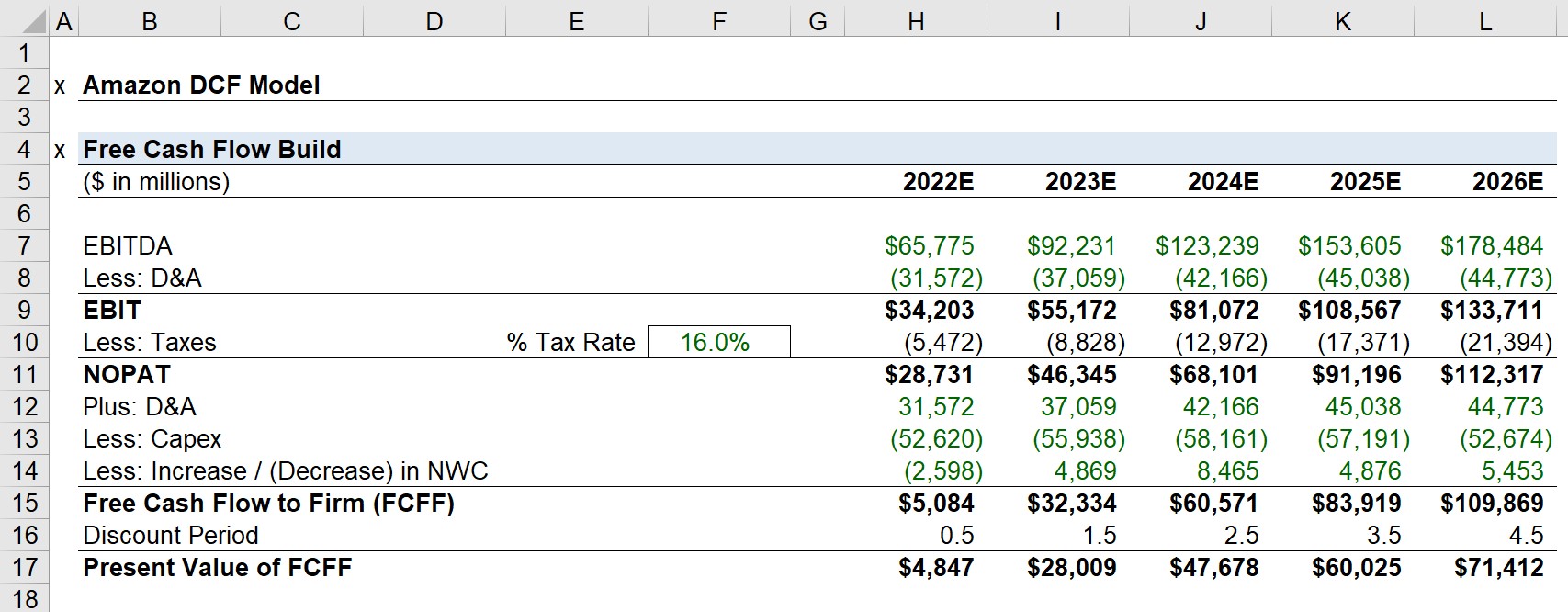

Finance
What Is Shipping Credit On Amazon
Published: January 9, 2024
Learn what shipping credit on Amazon is and how it affects your finances. Find out how to use shipping credit to save money on your purchases and boost your bottom line.
(Many of the links in this article redirect to a specific reviewed product. Your purchase of these products through affiliate links helps to generate commission for LiveWell, at no extra cost. Learn more)
Table of Contents
Introduction
Welcome to the world of Amazon, where buying and selling products has never been easier. From household items to electronics, clothing to books, you can find almost anything on this popular online marketplace. As a seller on Amazon, one of the key aspects you need to understand is shipping credit.
Shipping credit is an essential component of the Amazon ecosystem, affecting both buyers and sellers. In simple terms, it is a predetermined amount that Amazon provides to sellers to cover the shipping costs of their products. It plays a crucial role in determining the profitability and success of your business on the platform.
In this article, we will delve into the inner workings of shipping credit on Amazon. We will explore how it functions, how it differs from a shipping fee, and how it can be calculated. Additionally, we will share some useful tips on how to maximize your shipping credit to optimize your business operations.
Whether you are a new seller trying to grasp the nuances of Amazon or an experienced seller looking for ways to improve your shipping credit utilization, this article is a valuable resource. So, let’s dive in and unravel the intricacies of shipping credit on Amazon!
Understanding Shipping Credit on Amazon
Shipping credit is a monetary allowance provided by Amazon to sellers to cover the costs associated with shipping their products. It is essentially a reimbursement for the expenses incurred when fulfilling customer orders. Understanding how shipping credit works is essential for sellers to effectively manage their expenses and maximize their profits.
When a customer makes a purchase on Amazon, they are generally required to pay for the shipping of the product. However, Amazon offers a shipping credit to sellers to cover these costs. This credit is based on various factors, such as the weight and dimensions of the product, the shipping service used, and the destination of the package.
It’s important to note that shipping credit is not a fixed amount and can vary for each product. Amazon uses its own algorithms and calculations to determine the appropriate shipping credit for each item. This ensures that sellers are provided with a fair reimbursement based on the specific shipping requirements of their products.
Shipping credit is instrumental in enabling sellers to offer competitive pricing and attract customers. By effectively utilizing shipping credit, sellers can offset a portion or even the entirety of the shipping costs associated with fulfilling orders. This allows sellers to offer free or discounted shipping to customers, which can significantly increase sales and customer satisfaction.
Furthermore, shipping credit plays a crucial role in the Buy Box algorithm on Amazon. The Buy Box is the highlighted box on a product detail page where customers can directly add an item to their cart. Winning the Buy Box can lead to increased sales, as the majority of customers tend to purchase products from sellers listed in the Buy Box. By offering competitive shipping credit, sellers have a higher chance of winning the Buy Box and increasing their visibility on the platform.
Now that we have a basic understanding of shipping credit on Amazon, let’s explore how it works and how it differs from a shipping fee in the next section.
How Does Shipping Credit Work?
Shipping credit on Amazon operates on a reimbursement basis. When a customer places an order for a product, the shipping credit amount is deducted from the total shipping cost. The remaining balance is either covered by the customer or set as the shipping fee, depending on the seller’s pricing strategy.
The shipping credit amount is calculated based on various factors, including the weight, size, and shipping service selected by the customer. Amazon’s algorithms determine the appropriate shipping credit for each product, considering these factors and the seller’s location and shipping carrier options.
It’s important to note that the shipping credit is not a direct payment to the sellers. Instead, it is applied as a credit towards the shipping costs associated with fulfilling orders. Sellers can view the amount of shipping credit they receive for each product in their seller account or through third-party tools and software designed for Amazon sellers.
Sellers can choose to offer free shipping to their customers by setting the shipping fee equal to or less than the shipping credit amount. This can be a highly effective strategy to attract buyers, increase sales, and improve customer satisfaction. Alternatively, sellers can set the shipping fee higher than the shipping credit to cover any additional costs they may incur, such as packaging materials or handling charges.
It’s worth mentioning that in some cases, the shipping credit may not fully cover the actual shipping costs. This can happen if the seller is using a more expensive shipping service or if the product is oversized or overweight. In such situations, the seller would need to cover the remaining shipping fees out of pocket, and it’s important to factor these additional costs into their pricing strategy.
Amazon regularly updates its shipping credit calculations to ensure fairness and accuracy. Sellers should stay updated with any changes that may affect their shipping credit amounts and adjust their strategies accordingly. By monitoring and understanding how shipping credit works, sellers can make informed decisions to optimize their shipping costs and maximize their profits on Amazon.
Next, let’s explore the difference between shipping credit and shipping fees on Amazon.
Shipping Credit vs. Shipping Fee
When it comes to shipping on Amazon, it’s essential to understand the distinction between shipping credit and shipping fees. While they both relate to the costs associated with delivering products to customers, they serve different purposes and have different implications for sellers.
Shipping credit is the reimbursement amount provided by Amazon to sellers to cover their shipping expenses. It is based on various factors such as product weight, dimensions, shipping service selected, and destination. The shipping credit is applied as a credit towards the total shipping cost, either covering it in full or partially.
On the other hand, the shipping fee is the amount charged to customers when they purchase a product. This fee represents the portion of the shipping cost that is not covered by the shipping credit. Sellers have control over the shipping fee and can choose to set it higher or lower than the shipping credit amount.
One of the key differences between shipping credit and shipping fees is their impact on customers. Shipping credit is invisible to customers and is used behind the scenes to support sellers in covering their shipping costs. On the other hand, the shipping fee is transparent to customers and directly affects their purchasing decisions. Buyers consider the shipping fee when comparing prices and deciding whether to proceed with a purchase.
By offering competitive shipping credit and keeping the shipping fee low or even free, sellers can attract more customers and increase sales. Free shipping is often a selling point for customers, as it eliminates an additional cost and provides a seamless shopping experience.
It’s important to carefully consider the relationship between shipping credit and shipping fees when crafting a pricing strategy on Amazon. Sellers should evaluate their shipping costs, profit margins, and customer expectations to determine the optimal balance that drives sales while ensuring profitability.
Maximizing shipping credit utilization by offering cost-effective shipping options and controlling shipping fees can give sellers a competitive edge on Amazon. Additionally, providing transparent and reasonable shipping fees can enhance customer satisfaction and encourage repeat business.
Next, let’s explore how shipping credit is calculated on Amazon.
Calculating Shipping Credit
The calculation of shipping credit on Amazon involves several factors that determine the amount of reimbursement a seller receives for shipping their products. While the process is handled by Amazon’s algorithms, it’s essential for sellers to understand the basic principles behind this calculation.
Here are some key factors that influence the calculation of shipping credit:
- Product Weight and Dimensions: The weight and dimensions of the product play a significant role in determining the shipping credit amount. Heavier and larger items typically require more resources and incur higher shipping costs.
- Shipping Service Selected: The type of shipping service chosen by the customer, such as standard shipping or expedited shipping, impacts the shipping credit amount. Faster shipping options generally involve higher costs, which are accounted for in the calculation.
- Destination: The location to which the product is being shipped affects the shipping credit calculation. Shipping to certain regions or countries may incur higher costs due to distance or customs requirements.
- Shipping Carrier Options: Amazon provides sellers with various shipping carrier options, each with its own pricing structure. The shipping credit calculation considers the chosen carrier and its associated costs.
It’s important to note that Amazon’s algorithm handles the actual calculation of shipping credit for each product. The specific details of this algorithm are proprietary and regularly updated by Amazon to ensure accuracy and fairness for both sellers and buyers.
Sellers can access information about the shipping credit they receive for each product through their seller account dashboard or third-party tools and software designed for Amazon sellers. This allows sellers to monitor and analyze their shipping credit amounts to make informed decisions about their pricing strategy.
Keep in mind that the shipping credit calculation may not always cover the entire shipping cost, especially for oversized or overweight items or those requiring specialized handling. In such cases, sellers may need to cover the remaining shipping fees out of pocket.
By understanding the factors considered in the shipping credit calculation, sellers can strategically price their products and determine the most efficient shipping methods to maximize their profitability on Amazon.
Next, let’s explore some factors that can affect the shipping credit amount.
Factors Affecting Shipping Credit
The amount of shipping credit that sellers receive on Amazon is influenced by various factors. Understanding these factors can help sellers optimize their shipping strategies and make informed decisions about pricing and product offerings. Here are some key factors that can affect the shipping credit amount:
- Product Weight and Dimensions: The size and weight of the product have a direct impact on the shipping credit. Heavier and larger items generally require more resources and incur higher shipping costs, resulting in a higher shipping credit reimbursement.
- Shipping Service Selected: Different shipping services, such as standard shipping, expedited shipping, or international shipping, have varying costs associated with them. The shipping credit is influenced by the type of service selected by the customer.
- Package Destination: The location to which the product is being shipped plays a role in determining the shipping credit. Shipping to certain regions or countries may involve higher costs due to distance, customs requirements, or local shipping fees.
- Shipping Carrier and Method: Amazon offers multiple shipping carrier options, each with its own pricing structure. The specific carrier and shipping method chosen impact the shipping credit calculation.
- Seasonality and Peak Periods: During peak shopping seasons, such as holidays or special promotions, shipping costs may increase due to higher demand and carrier surcharges. These factors can affect the shipping credit amount for sellers.
- Seller Location: The geographic location of the seller can have an influence on the shipping credit calculation. Shipping costs may vary depending on the proximity to the product’s destination and the availability of specific carrier options in that location.
It’s important for sellers to consider these factors when setting their pricing strategy and making decisions related to shipping on Amazon. By understanding how these factors affect the shipping credit, sellers can choose the most cost-effective shipping options, optimize their product offerings, and ensure a positive customer experience.
Sellers should also stay updated with any changes to Amazon’s shipping policies and shipping credit calculations. Amazon regularly updates its algorithms to reflect market fluctuations and ensure fairness for both sellers and buyers. Monitoring these updates can help sellers make necessary adjustments to their strategies and maintain a competitive edge on the platform.
Now that we have explored the factors influencing shipping credit, let’s move on to the next section and understand how to effectively use shipping credit on Amazon.
Using Shipping Credit on Amazon
Shipping credit on Amazon provides sellers with a valuable opportunity to optimize their shipping strategies and offer competitive shipping options to their customers. Here are some key considerations for effectively using shipping credit on Amazon:
- Offering Free or Discounted Shipping: By setting the shipping fee equal to or less than the shipping credit amount, sellers can provide customers with free or discounted shipping. This can be a powerful incentive for buyers, as it eliminates an additional cost and can boost sales and customer satisfaction.
- Consider Shipping as a Marketing Tool: Shipping options can be used strategically to attract customers. For example, offering free shipping on orders above a certain value or using expedited shipping for time-sensitive products can enhance the perceived value of the purchase and attract more buyers.
- Monitor Shipping Costs: Even with shipping credit, it’s important for sellers to monitor and manage their shipping costs. This includes analyzing shipping fees charged by carriers, optimizing packaging to reduce weight and dimensions, and using affordable shipping materials to minimize expenses.
- Optimize Product Selection: Sellers can evaluate the profitability of their products by considering the associated shipping costs. It may be prudent to focus on products that have lower shipping expenses while still offering competitive pricing to customers.
- Consider Profile-Specific Shipping: Depending on the nature of their products, sellers can offer different shipping options. For example, lightweight items may be eligible for exclusive shipping services like first-class mail, which can save costs without compromising delivery speed.
- Use Fulfilled by Amazon (FBA) Services: Utilizing Amazon’s FBA services enables sellers to access Amazon’s vast fulfillment network. With FBA, Amazon takes care of storage, shipping, and customer service. Sellers can leverage FBA to simplify their shipping processes and potentially reduce costs.
Proper utilization of shipping credit can help sellers gain a competitive advantage, increase customer satisfaction, and improve overall profitability. It’s crucial to regularly assess and adjust shipping strategies based on customer feedback, market trends, and changes in shipping costs and regulations.
Additionally, sellers should closely monitor their shipping credit amounts and ensure they align with their business goals. Analyzing the shipping credit received for each product can help sellers make data-driven decisions about pricing, packaging, and shipping methods.
By effectively using shipping credit on Amazon, sellers can provide a seamless and cost-effective shipping experience for customers, ultimately driving sales and building a positive reputation on the platform.
Now, let’s uncover some expert tips for maximizing shipping credit on Amazon.
Tips for Maximizing Shipping Credit
Maximizing shipping credit on Amazon is crucial for sellers to optimize their profitability and offer competitive shipping options. Here are some expert tips to help sellers make the most of their shipping credit:
- Optimize Product Packaging: Streamlining product packaging can help reduce shipping costs. Using smaller and lightweight packaging materials can decrease dimensional weight charges and potentially lower shipping fees.
- Weigh and Measure Products Accurately: Accurate measurements and weight calculations ensure that sellers receive the appropriate shipping credit for their products. Using a reliable scale and measuring tools helps avoid discrepancies and potential underpayment or overpayment.
- Explore Shipping Carrier Options: Comparing different shipping carriers and their pricing structures can help sellers find the most cost-effective options. Researching and negotiating rates with carriers can potentially lead to reduced shipping expenses and increased shipping credit.
- Consider Zone Skipping: Zone skipping involves consolidating orders and shipping them in bulk to a central location closer to the customers’ destinations. This can result in significant savings, as the shipping credit will reflect the shorter distance in the final leg of the delivery.
- Use Dimensional Weight Calculations: Dimensional weight calculations take into account the size of the package in relation to its weight. By optimizing packaging dimensions, sellers can avoid higher shipping fees based on dimensional weight.
- Utilize Shipping Tools and Software: There are several third-party tools and software designed for Amazon sellers that can help optimize shipping processes. These tools provide insights into shipping credit calculations, carrier rates, and shipping labels, making it easier to maximize shipping credit.
- Regularly Review Shipping Credit Amounts: Keep track of the shipping credit received for each product and analyze any fluctuations. Stay informed about potential changes to Amazon’s shipping credit algorithms and adjust strategies accordingly.
- Experiment with Different Shipping Strategies: Test different shipping methods, carrier options, and packaging techniques to find the most cost-effective and efficient approach. Continuously evaluate customer feedback and adjust strategies based on their preferences and needs.
- Investigate Amazon’s Seller Central Resources: Amazon provides resources and guidelines for sellers to optimize their shipping practices. Exploring the Seller Central platform can uncover valuable information and best practices for maximizing shipping credit.
- Consider Outsourcing Shipping Operations: For larger sellers or those facing complex shipping requirements, outsourcing the shipping process to a third-party logistics (3PL) provider can help optimize shipping credit utilization, reduce costs, and streamline operations.
Implementing these tips can lead to improved shipping credit utilization and enhanced profitability for sellers on Amazon. It’s essential to continually evaluate and adjust shipping strategies to align with customer expectations, market trends, and changes in Amazon’s policies.
By effectively managing shipping credit, sellers can attract more customers with competitive shipping options, increase sales, and ultimately build a successful and profitable business on Amazon.
Conclusion
Understanding and effectively utilizing shipping credit on Amazon is crucial for sellers to succeed in the competitive online marketplace. Shipping credit provides reimbursement for shipping costs and plays a vital role in pricing strategies, customer satisfaction, and overall profitability.
In this article, we have explored the fundamentals of shipping credit on Amazon, highlighting its importance and how it differs from shipping fees. We have discussed factors that influence shipping credit calculations, such as product weight, dimensions, shipping service, destination, and seller location. Additionally, we have provided tips to help sellers maximize their shipping credit and optimize their shipping strategies.
By leveraging shipping credit effectively, sellers can offer free or discounted shipping options, which can attract more customers and increase sales. Carefully monitoring shipping costs, exploring carrier options, and optimizing packaging can help sellers reduce expenses and maximize their shipping credit utilization.
Regularly reviewing and adjusting shipping strategies based on customer feedback, market trends, and changes in Amazon’s shipping policies is essential for sellers to stay competitive and maintain profit margins. Leveraging third-party tools and resources from Amazon’s Seller Central can also contribute to maximizing shipping credit.
Ultimately, by understanding how shipping credit works, implementing best practices, and actively managing shipping operations, sellers can enhance customer satisfaction, increase sales, and build a solid foundation for long-term success on Amazon.
So, take the knowledge and tips shared in this article and apply them to your Amazon business. By strategically using your shipping credit, you can create a seamless and cost-effective shipping experience that keeps your customers happy and boosts your Amazon sales.














